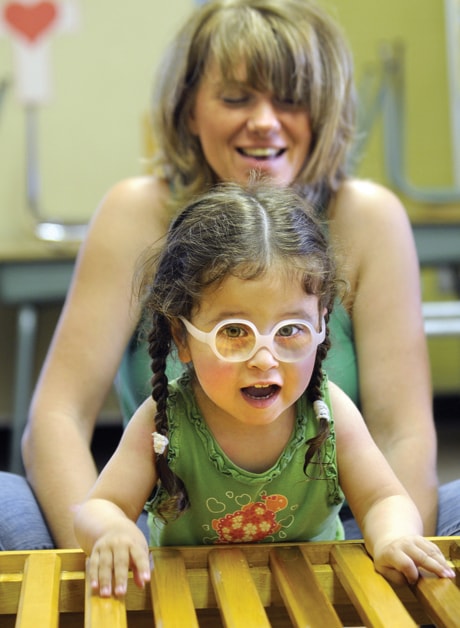Like all good parents, Khrissy and Tim Bartolowits want to see their three children, Sean, 15, Jacob, 6, and Sarah, 2, live independently one day.
For Jacob, the journey will be more challenging than it will be for his siblings. He suffered a stroke before he was born that left him with muscle rigidity in his legs and left arm, a condition called spastic triplegia.
Assnd that challenge is why, one recent morning, Jacob, a sunny child with a cute cap of sorta-curly brown hair, was hard at work in his twice-weekly conductive education session, along with two other children with developmental delays, in a classroom at Most Holy Name Parish in Pittsburgh.
This preschool program is the baby of three families of young children who have begun to assume the responsibilities of running Conductive Education of Pittsburgh, said Tina Calabro, who helped establish that program in 1998. And the families of the younger children have a new name for the organization: Steps to Independence.
Conductive education was developed in 1945 in Hungary by Dr. Andras Peto for people with cerebral palsy and other motor challenges.
It embraces task series, motivation and peer connections to help these individuals gain movement and social skills and, ultimately, as much independence as possible.
It’s based on the idea that the brain can create alternate neural pathways to replace damaged ones.
Teachers, called conductors, complete a four-year program at the International Peto Institute of Conductive Education in Budapest, Hungary, or at Aquinas College in Grand Rapids, Mich.
“It’s very hard work, but Jacob has adjusted well,” said his mom.
“In particular, his left-hand strength has improved to the point where “he is no longer using his mouth as his second hand.”
He also is able to take steps holding just her fingertips, something that children without delays accomplish much earlier in their young lives.
That recent class began with the children and their teacher, Krisztina Weiszhaupt, singing a good-morning song and the children — Jacob, Mitchell Case, 5, and Maya Torres, 3 — answering her questions about their weekends.
Maya is nonverbal and has a push-button device with answers already recorded on it, and both boys frequently gave her encouragement as she reached to push the button.
Then came the exercises, progressing from a lying position, to sitting, to standing and then walking.
They used balls in kicking exercises meant to practice the motion of the foot during walking, sparkly plastic wands to help rigid muscles stretch and played musical instruments and received rewards for tasks well done.
All through lots of songs, praise and encouragement.
“For Jacob (who is learning to walk with canes) the goal is to be able to take some steps with close supervision and verbal instructions and to be able to stand for longer periods of time,” said Weiszhaupt, a graduate of the four-year program for teachers at the Peto Institute.
Toward the end of class, Jacob, wearing a red T-shirt and blue madras shorts, did his walking exercise, with Zo Re, Weiszhaupt’s assistant.
“Standing tall,” she sang out, as she steadied Jacob, who wore plastic braces around his calves and supported himself with two canes. “Standing tall!” Jacob repeated and then she released him and watched as he held himself steady.
As the count neared 20, Jacob, though starting to wobble, flashed a big grin.
“I did it!” he beamed.
For children with motor and cognitive disabilities, conductive education is a complement to the other array of therapies and activities they participate in.
“It’s a program that is best started when a child is young because it teaches a child to do more things for themselves,” said Calabro. “So it becomes a lifestyle for them and their families.
“It is a unique program, but it doesn’t say ‘do this instead of everything else.’ “
Dori Ortman, program coordinator for Pittsburgh’s United Cerebral Palsy Kids, which serves children with all kinds of developmental disabilities, explained that with so many challenges facing parents of these children, it’s important to key on what’s best for the child, rather than trying to determine whether one therapy or approach might be better than another.
“We’ve heard some wonderful things about it (CE), but we’re not out there recommending therapies for anyone,” she said.
“You have to make the best decision for your family and your child.
“What we (at UCP Kids) try to focus on is what we believe: That the best outcomes come from kids’ involvement in the community. How can we change the community to accept that child for who they are?”
Jacob’s mother, along with Maya’s and Mitchell’s moms, Abby Torres and Elizabeth Case, hope to bring more children in need into the conductive-education fold. “I really feel like we are witnessing tiny miracles every day,” said Khrissy Bartolowits.
More information, visit www.stepstoindependence.org.
